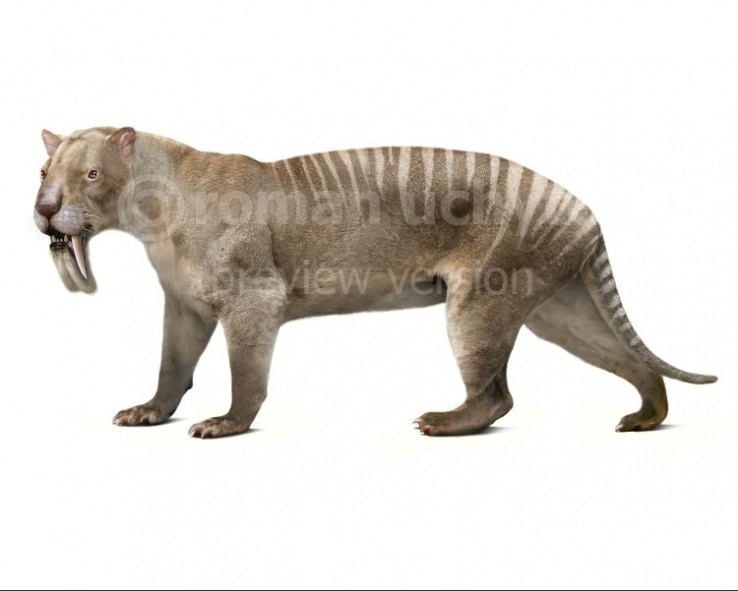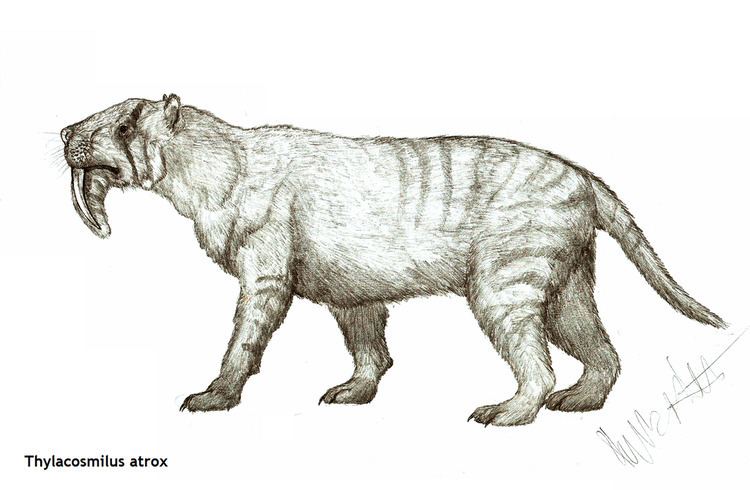Scientific name Thylacosmilus Order Sparassodonta | Infraclass Metatheria Species T. atrox Phylum Chordata Rank Genus | |
 | ||
Similar Sparassodonta, Saber‑toothed tiger, Thylacoleo, Homotherium, Macrauchenia | ||
Thylacosmilus atrox smilodon fatalis and modern cats
Thylacosmilus atrox is an extinct species of saber-toothed metatherian that inhabited South America from the late Miocene to Piacenzian epochs. Remains of this animal have been found primarily in Catamarca, Entre Ríos, and La Pampa Provinces in northern Argentina.
Contents
- Thylacosmilus atrox smilodon fatalis and modern cats
- Reconstruyen el esqueleto de un thylacosmilus en el museo de miramar
- Description
- Extinction
- References

Though Thylacosmilus is one of several predatory mammal genera typically called "saber-toothed cats", it was not a felid but a sparassodont, a group closely related to marsupials, and only superficially resembled other saber-toothed mammals due to convergent evolution.

Reconstruyen el esqueleto de un thylacosmilus en el museo de miramar
Description

Thylacosmilus had large, saber-like canines. The roots of these canines grew throughout the animal’s life, growing in an arc up the maxilla and above the orbits. Its cervical vertebrae were very strong and to some extent resembled the vertebrae of Machairodontinae. Recent comparative biomechanical analysis have estimated the bite force of T. atrox starting at maximum gape at 38 newtons (8.5 lbf), much weaker than that of a leopard, suggesting its jaw muscles had an insignificant role in the dispatch of prey. Its skull was similar to that of Smilodon in that it was much better adapted to withstand loads applied by the neck musculature, which, along with evidence for powerful and flexible forelimb musculature and other skeleton adaptations for stability, support the hypothesis that its killing method consisted on immobilization of its prey followed by precisely directed, deep bites into the soft tissue driven by powerful neck muscles.
Body mass estimates of Thylacosmilus suggest this animal weighed between 80–120 kilograms (180–260 lb), and one estimate suggesting up to 150 kg (330 lb), about the same size as a modern jaguar. This would make it one of the largest known carnivorous metatherians.

Based on studies of its habitat, Thylacosmilus is believed to have hunted in savannah-like or sparsely forested areas, avoiding the more open plains where it would have faced competition with the more successful and aggressive Phorusrhacids it shared its environment with.
Extinction
Although older references have often stated that Thylacosmilus became extinct due to competition with the “more competitive” saber-toothed cat Smilodon during the Great American Interchange, newer studies have shown this is not the case. Thylacosmilus died out during the Piacenzan (3.6–2.58 mya) whereas saber-toothed cats are not known from South America until the Middle Pleistocene (781-126,000 years ago). As a result, the last appearance of Thylacosmilus is separated from the first appearance of Smilodon by over one and a half million years.
